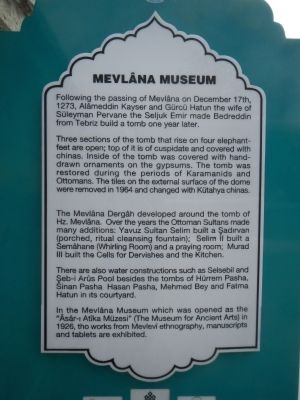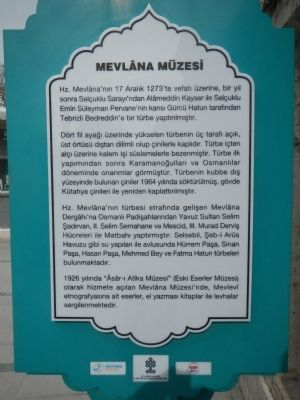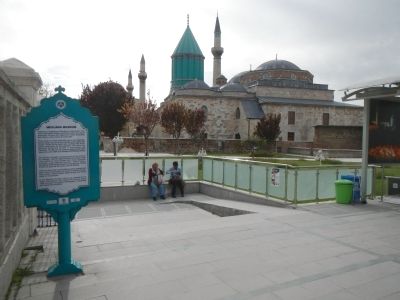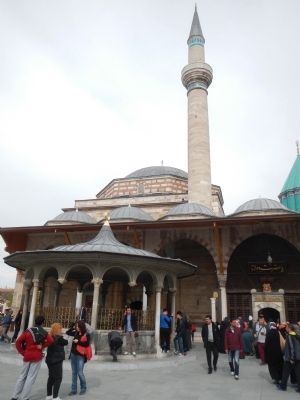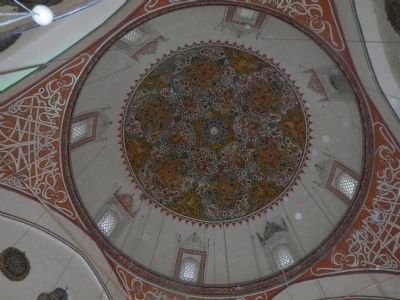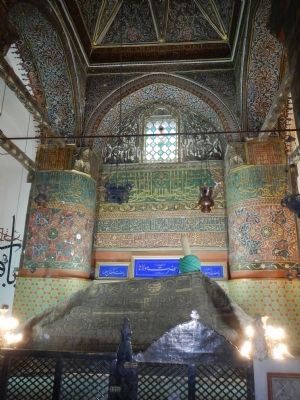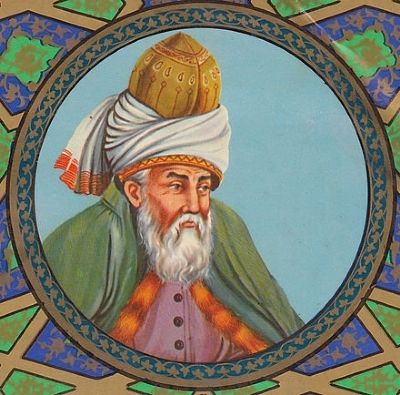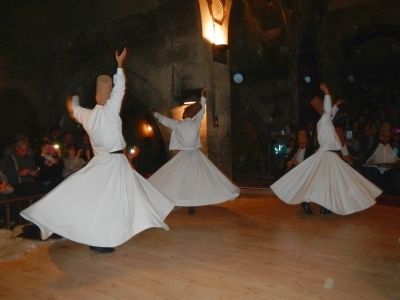Aziziye in Konya in Karatay, Turkey — West Asia or Southeast Europe
Mevlâna Museum
Mevlâna Müzesi
Following the passing of Mevlâna on December 17th, 1273, Alâmeddin Kayer and Gürcü Hatun the wife of Süleyman Pervade the Seljuk Emir made Bedridden from Tebriz build a tomb one year later.
Three sections of the tomb that rise on four elephant-feet are open; top of its is cuspidate and covered with chinas. Inside of the tomb was covered with hand-drawn ornaments on the gypsums, The tomb was restored during the periods of Karamanids and Ottomans. The tiles on the external surface of the dome were removed in 1964 and changed with Kütahya chinas.
The Mevlâna Dergâh developed around the tomb of Hz. Mevlána. Over the years the Ottoman Sultans made many additions: Yavuz Sultan Selim built a Şadirvan (porched, ritual cleansing fountain); Selim II built a Semâhane (Whirling Room) and a praying room; Murad III built the Cells for Dervishes and the Kitchen.
There are also water constructions such as Selsebil and Şeb-i Arûs Pool besides the tombs of Hürrem Pasha, Sinan Pasha, Hasan Pasha, Mehmed Bey and Fatma Hastun in its courtyard.
In the Mevlâna Museum which was opened as the Âsâr-ı Atîka Müzesi (The Museum for Ancient Arts) in 1926, tho works from Mevlevi ethnography, manuscripts and tablets are exhibited.
Turkish:
Hz. Melânanın 17 Aralık 1273te vefatı üzerine, bir yıl sonra Selçuklu Sarayından Alâmedin Kayser ile Selçuklu Emîri Süleman Pervanenin karısı Gürcü Hatun tarafından Tebrizli Bedreddine bir türbe yaptırılmıştır.
Dört fil ayaǧı üzerinde yükselen tübenin üç, tarafı açık, üst örtüsü dıştan dilimli olup çinilerle kaplıdır. Türbe içten alçı üzerine kalem işi süslemelerle bezenmiştir. Türbe ilk yapımından sonra Karamanoǧulları ve Osmanlılar döneminde onarımlar görmüştür. Tübenin kubbe dış yüzeyinde bulunan çiniler 1964 yılında söktürülmuş, gövde Kütahya çinileri ile yeniden kaplattırılmıştır.
Hz. Mevlânanın türbesi etrafında gelişen Mevlâna Dergâhina Osmanlı Padişahlarından Yavuz Sultan Selim Sadırvan, II. Selim Semahane ve Mescid, III. Murad Derviş Hücreleri ile Matbahı yaptırmıştır. Selebil, Şeb-i Arûs Havuzu gibi su yapıları ile avlusunda Hürrem Paşa, Sinan Paşa, Hasan Paşa, Mehmed Bey ve Fatma Hatun türbeleri bulumaktadır.
1926 yılıbda Âsâr-ı Atîka Müzesi (Eski Eserler Müzesi) olark hizmete açılan Mevlâna Müzesinde, Mevlevî etnografyasına ait eserler, el yazması kitaplar ile levhalar sergilenmektedir.
Topics. This historical marker is listed in these topic lists: Cemeteries & Burial Sites • Churches & Religion. A significant historical date for this entry is December 17, 1273.
Location. 37° 52.23′ N, 32° 30.349′ E. Marker is in Konya, in Karatay. It is in Aziziye. Marker can be reached from Aslanli Kisla Cadde close to Celal Sokak, on the right when traveling west. Touch for map. Marker is in this post office area: Konya 42250, Turkey. Touch for directions.
Other nearby markers. At least 1 other marker is within walking distance of this marker. The Tomb of Ahmed Eflâkî Dede (within shouting distance of this marker).
More about this marker. This marker is near the entrance on the museum grounds.
Also see . . . Rumi - Wikipedia. .Jalāl ad-Dīn Muhammad Rūmī ... and more popularly simply as Rūmī (1207 – 17 December 1273), was a 13th-century Persian poet, jurist, Islamic scholar, theologian, and Sufi mystic. Rumi's influence transcends national borders and ethnic divisions...(and others) have greatly appreciated his spiritual legacy for the past seven centuries. (Submitted on June 6, 2015, by Barry Swackhamer of Brentwood, California.)
Credits. This page was last revised on February 13, 2023. It was originally submitted on June 6, 2015, by Barry Swackhamer of Brentwood, California. This page has been viewed 444 times since then and 11 times this year. Last updated on June 11, 2015, by Barry Swackhamer of Brentwood, California. Photos: 1, 2, 3, 4, 5, 6, 7, 8. submitted on June 6, 2015, by Barry Swackhamer of Brentwood, California. • Andrew Ruppenstein was the editor who published this page.
